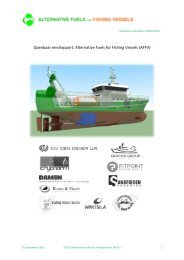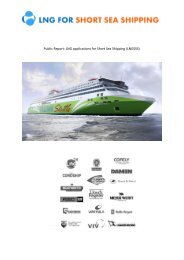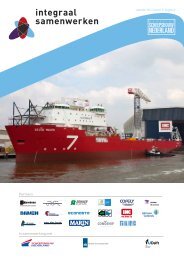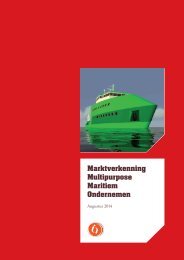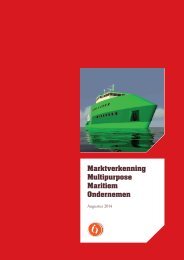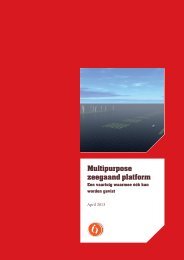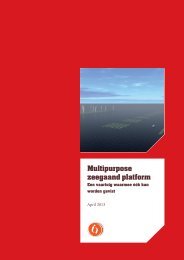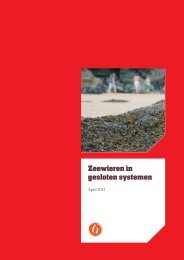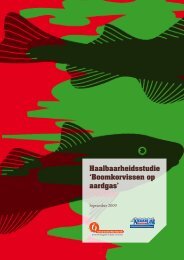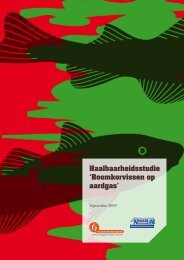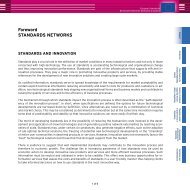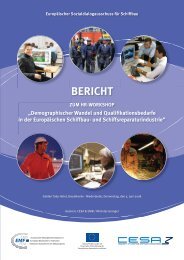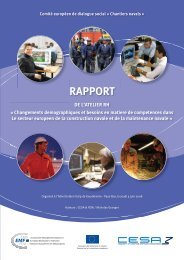Summary: Seaweeds in closed systems (2011)
A feasibility study for growing seaweeds in closed barges at sea.
A feasibility study for growing seaweeds in closed barges at sea.
Create successful ePaper yourself
Turn your PDF publications into a flip-book with our unique Google optimized e-Paper software.
Zeewieren <strong>in</strong><br />
gesloten systemen<br />
April <strong>2011</strong>
Zeewieren <strong>in</strong><br />
gesloten systemen<br />
Dit rapport is <strong>in</strong> opdracht van InnovatieNetwerk opgesteld door:<br />
Pieter 't Hart (Koers & Vaart BV)<br />
In samenwerk<strong>in</strong>g met:<br />
Job Schipper (Hortimare)<br />
Projectleider InnovatieNetwerk:<br />
Dr.ir. J.G. de Wilt<br />
Dit rapport is opgesteld b<strong>in</strong>nen het dome<strong>in</strong> ‘Land- en tu<strong>in</strong>bouw en agribus<strong>in</strong>ess’, concept<br />
‘Mariene Parken’.<br />
Postbus 19197<br />
3501 DD Utrecht<br />
tel.: 070 378 56 53<br />
www.<strong>in</strong>novatienetwerk.org<br />
Het m<strong>in</strong>isterie van EL&I nam het <strong>in</strong>itiatief tot en f<strong>in</strong>anciert InnovatieNetwerk.<br />
ISBN: 978 – 90 – 5059 – 446 – 2<br />
Overname van tekstdelen is toegestaan, mits met bronvermeld<strong>in</strong>g.<br />
Rapportnr. 11.2.259, Utrecht, april <strong>2011</strong>.
<strong>Summary</strong><br />
45<br />
Seaweed <strong>in</strong> <strong>closed</strong> <strong>systems</strong> (SICS)<br />
Hart, P. ‘t (Koers & Vaart B.V) and J. Schipper (Hortimare)<br />
InnovationNetwork Report No. 11.2.259, Utrecht, The Netherlands,<br />
April <strong>2011</strong>.<br />
Seaweed is a potential source of green raw materials. They are used<br />
for human consumption, conta<strong>in</strong> specific thicken<strong>in</strong>g agents such as<br />
alg<strong>in</strong>ates and carrageenans, and can be applied as growth-promot<strong>in</strong>g<br />
fertilizers, <strong>in</strong> animal feed and for the cultivation of shellfish (abalones).<br />
In addition, extracts from seaweed are used <strong>in</strong> cosmetics and pharmaceutical<br />
products and seaweeds also constitute a possible source of<br />
biofuels. Seaweed can possibly also serve as a prote<strong>in</strong> platform for<br />
cater<strong>in</strong>g to the steadily grow<strong>in</strong>g demand for fish prote<strong>in</strong> and soy<br />
prote<strong>in</strong>.<br />
Though the Netherlands has a good reputation <strong>in</strong> offshore and<br />
hydraulic eng<strong>in</strong>eer<strong>in</strong>g as well as <strong>in</strong> seed cultivation and improvement,<br />
the knowledge of cultivat<strong>in</strong>g and harvest<strong>in</strong>g seaweed is very limited.<br />
With the advent of w<strong>in</strong>d farms <strong>in</strong> the North Sea and the commercial<br />
exploitation of the cont<strong>in</strong>ental shelf, the opportunities for cultivat<strong>in</strong>g<br />
seaweed are now also be<strong>in</strong>g explored. Both extensive and <strong>in</strong>tensive<br />
cultivation <strong>systems</strong> as used <strong>in</strong> agriculture and horticulture are be<strong>in</strong>g<br />
considered.<br />
Certa<strong>in</strong> applications of seaweed require more controlled cultivation<br />
conditions. This is the case with specific plant substances, nutritional<br />
factors and with the propagation of seaweed for large-scale cultivation.<br />
Wherever the value of the cultivated seaweed <strong>in</strong>creases, and hence the<br />
need for harvest security and risk control, <strong>closed</strong> <strong>systems</strong> are probably<br />
the best approach.
46<br />
As the cultivation conditions can be more easily controlled <strong>in</strong> <strong>closed</strong><br />
<strong>systems</strong>, the yields are expected to be bigger, the quantities of plant<br />
substances more consistent and the overall quality better. In addition,<br />
pests are easier to control or prevent. In contrast with land-based<br />
seaweed cultivation, <strong>closed</strong> <strong>systems</strong> benefit from the abundant<br />
availability of clean and relatively low-m<strong>in</strong>eral seawater. This makes it<br />
possible to control the temperature with the aid of seawater. The<br />
concept of seaweed <strong>in</strong> <strong>closed</strong> <strong>systems</strong> is <strong>in</strong> some ways comparable to<br />
greenhouse horticulture.<br />
Given the present prices for seaweed, the cultivation of mature plants<br />
<strong>in</strong> <strong>closed</strong> <strong>systems</strong> for <strong>in</strong>dustrial applications is not feasible. Even with<br />
fast-grow<strong>in</strong>g types and relatively expensive seaweeds, the <strong>in</strong>vestment<br />
costs of a <strong>closed</strong> cultivation system are too high. Palmaria Palmata can<br />
be commercially cultivated from basic material <strong>in</strong>to mature plants for<br />
consumption us<strong>in</strong>g concrete tanks, but not us<strong>in</strong>g steel tanks. Ulva<br />
lactuca cannot be commercially cultivated for consumption purposes,<br />
whether <strong>in</strong> concrete tanks or steel tanks. In addition, consumer<br />
demand for Ulva lactuca <strong>in</strong> Europe is currently very small.<br />
Nurtur<strong>in</strong>g basic materials <strong>in</strong>to young plants <strong>in</strong> steel tanks is feasible <strong>in</strong><br />
economic, technical and social terms. The preference is for steel tanks<br />
with a tidal upweller system, which is very flexible and can also be<br />
used as a fully <strong>closed</strong> system.<br />
Young plants can also be nurtured <strong>in</strong> concrete tanks at sea. However,<br />
concrete tanks are more vulnerable and less flexible at sea compared to<br />
steel tanks.<br />
Young plants can also be nurtured <strong>in</strong> onshore tanks. In view of the<br />
great need for clean seawater, the problems <strong>in</strong> ma<strong>in</strong>ta<strong>in</strong><strong>in</strong>g the right<br />
water temperature on land and the bigger risk of tank pollution, a<br />
<strong>closed</strong> offshore system is the preferred option. The use of offshore<br />
<strong>closed</strong> <strong>systems</strong> for propagat<strong>in</strong>g plant materials for large-scale<br />
cultivation appears to be an <strong>in</strong>dispensable l<strong>in</strong>k <strong>in</strong> the cha<strong>in</strong>.<br />
In view of the nature and scope of this feasibility study, not all<br />
questions can be answered <strong>in</strong> detail. However, the conclusion is that<br />
seaweed cultivation <strong>in</strong> offshore float<strong>in</strong>g <strong>systems</strong> is viable <strong>in</strong> the Dutch<br />
situation. The nurtur<strong>in</strong>g of young plant material <strong>in</strong> <strong>closed</strong> <strong>systems</strong><br />
may be an essential l<strong>in</strong>k <strong>in</strong> the large-scale offshore cultivation on l<strong>in</strong>es<br />
and/or nets.




